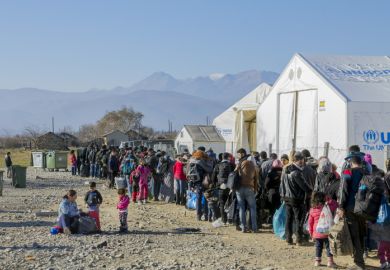Using electronic credentials to replace paper diplomas and transcripts has been touted as a way to prevent fraud and ease students’ transfer from institution to employer, but is going fully digital a step too far?
Technology’s ability to change how humans work, live and learn appears endless. Universities can now beam lectures to any corner of the planet, and learning analytics provide institutions with up-to-date information about how students are coping in a class. One of the most recent trends in global higher education is the increasing use of electronic credentials instead of physical ones. But with every new innovation, a new range of concerns arise, such as risks of cyberattacks and questions around accessibility and standardisation.
Chiara Finocchietti, deputy director of the Information Centre on Mobility and Equivalences (CIMEA) in Italy, says that going digital is a way to simplify the secure exchange of credentials for students and professionals and to reduce fraud.
CIMEA operates a Credential Information Service, which uses its Diplome service to issue certificates that recognise Italian and foreign qualifications. CIMEA experts will produce a “statement of comparability” relating to an institution’s qualification or a “statement of verification” referring to a particular qualification.
The statement is uploaded to the digital “wallet” of qualifications through the use of blockchain, making the digital document transparent, transferable, certified and unchangeable. Blockchain is a growing list of records or transactions, known as blocks, that are linked through encryption. Blockchain is designed to be resistant to data alteration – it’s used in Bitcoin transactions. “We have completely digitalised the process,” Finocchietti says. CIMEA is the certifying authority, not the awarding authority: the centre’s experts evaluate Italian or foreign qualifications of the higher education system and final qualifications of secondary school courses that allow access to higher education courses and then issue the statements.
“It’s a cultural shift,” she says. “We are working with a number of Italian higher education institutions, but the idea would be to have an open ecosystem, because we are using open technology,” she adds.
Finocchietti says issuing credentials in this way reduces fraud because you cannot change information once it is there. “That’s why it’s so interesting and powerful. Also, in blockchain the source is linked to the information itself, so if you share your qualification or your statement and the receiving person can see the source of the information, for example, from the University of Bologna, they can be sure about the authenticity of the document they are receiving.”
Key to the system is that CIMEA has to give permission to those who apply for statements of comparability or verification. “Otherwise we will have diploma mills and fake institutions trying to upload qualifications on to the blockchain system and using this as a way to legitimise themselves,” she explains. “When we launched the service, we straightaway received a number of diplomas from fake institutions. Of course they would [try to send fake diplomas to us]: a statement of comparability would legitimise them.”
At the moment, CIMEA is working with universities to issue the final qualification on blockchain, but Finocchietti says there is an ongoing discussion to fully integrate the academic career of the student into the technology.
Finocchietti adds that they do still offer the credentials in a PDF form. This is to be inclusive and a recognition that culturally it can be important to have that paper document, she says. “What is interesting is that on the PDF there is a link to the verification and the verification for the blockchain. The PDF is just a way to present the data because the data are on blockchain,” she adds.
“In the future, credentials will be digital,” she says. Humans are increasingly mobile, and their qualifications need to move with them. “You can’t always bring paper with you. A digital system of exchanging qualifications and credentials will help a lot. It is secure, it is simple and it is certifiable – you can trust the system. That’s what we are trying to do,” she says.
Matthew Pittinsky, chief executive of Parchment, a US-based company specialising in the digital transfer of diplomas and transcripts, and an assistant research professor at Arizona State University, agrees that the ease of transfer and access to credentials is crucial.
This is particularly true for countries experiencing instability, he says. “If you have to get up and leave suddenly and didn’t have time to gather your paper records, digital credentials are a secure store so you can still access those records.” Migrants will need those professional and academic credentials to practise their profession in their host countries, he adds.
However, Pittinsky says that higher education has been slow to innovate in this area and the technology is still in its infancy.
In the US, Comprehensive Learner Records – digital records of learners’ academic achievements as well as internships and extracurricular activities – are becoming more common but are still the minority, he explains. The UK has the Higher Education Achievement Report, which provides a single, comprehensive record of a person’s achievement. It is a digital transcript that individuals can access once they have finished their studies. In Australia, there is the Australian Higher Education Graduation Statement, which provides information on a person’s higher education qualification, the institution at which the qualification was obtained and the Australian higher education system in “one easy to read document”, according to the Australian government.
Pittinsky says the purpose of a credential is to communicate what a graduate knows and how well they know it. “If you think about the traditional paper documents – academic transcripts, which in the US context speaks to courses, credits and grades, and the diploma, which only tells you [little] more than the name and the degree – our credentials for a long time have been outdated in how effectively they communicate what someone knows and how well they know it.”
The exciting thing about digital credentials is not just that they make things more efficient – as helpful as that is – but how they can allow us to reimagine what a credential communicates and how it is presented, Pittinsky says. “It is the ability to speak to things such as leadership, soft skills and other parts of the university experience beyond what happens in the classroom,” he says, noting how the records can show more than just degree outcomes and academic transcripts.
Valère Meus, coordinator of Erasmus Without Paper, a project co-funded by the European Commission to digitise Erasmus administration, says student data exchange is usually slow and inefficient.
“Most of it is still done by snail mail, email or by sending PDFs, but even that cannot really be considered digitalisation, since it is only a digital ‘photocopy’, often not authenticated,” he explains. “When we talk about data exchange, the aim should be to exchange machine-readable data directly between secure servers.”
This is similar to what the banking sector has done: most of the financial data – which are encrypted – are directly retrieved and exchanged from the databases where they originate, Meus explains. In this way, no duplication is ever needed or data re-entered, which results in huge savings in time and labour and also greatly boosts security, he adds.
It means students can easily consult their data, avoiding lengthy bureaucratic procedures or trips to their institution. “We are still a long way away from a European diploma register, which should be the ultimate goal in this,” he says. Using blockchain is likely to be the solution, he adds.
The challenges that digital credentials present are mainly connected to the standardisation of procedures and data. If the information is to be transmitted digitally across the globe, that information has to be able to be read and understood by whoever receives it, Meus says.
This is a particular challenge for smaller institutions, which will have to adapt their local information systems and make them ready for international data exchange, which could involve a major overhaul of software systems, he says. The EU, for example, has said it wants to have a common digital European Area of Education by 2025.
Pittinsky agrees that standardisation will be an issue, particularly if credentials expand to chronicle more than just a name, an institution and a degree classification. “People know how to read an academic record; we can make sense of them generally. If institutions are innovating their records, there is a risk for global employers and global admissions to universities that it becomes more difficult to interpret the context across countries,” he says, noting the potentially contradictory aims of using this technology. “On the one hand, we want more information; but on the other hand, an employer looks at a CV in however many seconds, so we need to make sure it’s not more difficult to interpret.”
The fear of cyberattacks on digitised credentials is not unfounded considering high-profile data breaches at Facebook, British Airways and US-based consumer credit reporting agency Equifax. But experts are sceptical that these certificates are any more insecure than paper credentials. Credential fraud itself is not rare, but electronic credential fraud is, Pittinsky says. Electronic credentials are safer because the format makes it easier to detect fraud, but there is still a “risk and vulnerability you have to try to stay on top of”, he says.
According to Daniel Thomas Hickey, professor and programme coordinator of the Learning Sciences Program at Indiana University Bloomington, “It is kind of like asking if there are downsides to using the internet.” There are, of course, new issues and challenges involved in moving to digital credentials, he says, but there are always challenges. “Digital credentials are simply inevitable.”
Hickey also points to the increasing use of open badges, which recognise a range of learning accomplishments outside the scope of conventional credentials.
“Sceptics might want to consider that the existing system for recognising, credentialing and accrediting achievement in higher education evolved over a century, alongside practices for admitting applicants, advancing students and hiring graduates. These practices are very entrenched, opaque and analogue,” Hickey says. “They can’t resist the inevitable transformation by digital technology forever.”
Register to continue
Why register?
- Registration is free and only takes a moment
- Once registered, you can read 3 articles a month
- Sign up for our newsletter
Subscribe
Or subscribe for unlimited access to:
- Unlimited access to news, views, insights & reviews
- Digital editions
- Digital access to THE’s university and college rankings analysis
Already registered or a current subscriber?



